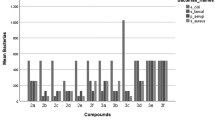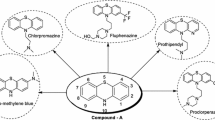Abstract
In order to evaluate the antimicrobial effect of 2,3-disubstituted-1,4-naphthalenedione derivatives, we synthesized several 2-chloro, 2-bromo and 2-hydroxy-3-(substituted)-1,4-naphthalenediones (1–25). These derivatives were tested for antifungal and antibacterial activities,in vitro, againstCandida albicans 10231 and local,Aspergillus niger KCTC 1231,Tricophyton mentagrophytes KCTC 6085,Bacillus subtilis ATCC 6633,Pseudomonas aeruginosa NCTC 10490,Staphylococcus aureus ATCC 6538p,Escherichia coli NIHJ. The MIC values were determined by the two-fold agar dilution/streak method. Among these derivatives, 4, 5 and 6 showed the potent antifungal activities. Also 5 and 6 had the antibacterial activities. 5 with (1,2,4-triazolyl)-amino moiety was the most effective in preventing the growth of fungi, such asCandida albicans, Aspergillus niger andTricophyton mentagrophytes.
Similar content being viewed by others
References Cited
Hodnet, E. M., Wongweichintana, C., Dunn, W. and Marrs, M., Substituted 1,4-naphthoquinones vs. the ascitic sarcoma 180 of mice.J. Med. Chem., 26, 570–574 (1983).
Kerkar, V. D., Mhaske, R. B., Kulkarni, P. L. and Kulkarni, A. R., Antimicrobial studies of some juglones.Indian J. Pharm. Soc., 49, 184–186 (1987).
Kirk-Othmer,Encyclopedia of Chemical Technology, Vol. 2, 3rd Edn., John Wiley & Sons, New York, 1978, p. 852–868.
Lorian, V.,Antibiotics in Laboratory Medicine, 3rd Edn., Williams and Wilkins, Baltimore, 1991, p. 198–239.
Lin, T. S., Zhu, L. Y., Xu, S. P., Divo, A. and Sartorelli, A., Synthesis and antimalarial activity of 2-aziridinyl-and 2,3-bis-(aziridinyl)-1,4-naphthoquinonyl sulfonate and acylate derivatives.J. Med. Chem., 34, 1634–1639 (1991).
Ryu, C. K. and Kim, D. H., The synthesis and antimicrobial activities of 1,4-naphthoquinones (II).Arch. Pharm. Res., 15(3), 263–268 (1992).
Ryu, C. K., Ryu, J. C., Chung, C. Y. and Kim, D. H., Antimicrobial activities of 1,4-naphthoquinone derivatives.Yakhak Hoeji, 36(2), 110–114 (1992).
Silver, R. F. and Holmes, H. L., Synthesis of some 1,4-naphthoquinones and reactions relating to their use in the study of bacterial growth inhibition.Canadian J. Chem., 46, 1859–1854 (1968).
Takeda, Y., Sawada, M., Kunai, H., Inouye, Y. and Nakamura, S., Mechanism of inhibition of reverse transcriptase by quinone antibiotics.J. Antibiotics, 39, 557 (1986); 41, 1471–1478 (1988).
Wurm, G., Geres, U. and Schmidt, H., Untersuchungen an 1,4-Naphthoquinonen.D.Apotheker Zeitung, 43, 2045–2051 (1980).
Author information
Authors and Affiliations
Rights and permissions
About this article
Cite this article
Ryu, CK., Kim, DH. The antimicrobial activities of some 1,4-naphthalenediones (III). Arch. Pharm. Res. 16, 161–163 (1993). https://doi.org/10.1007/BF03036867
Received:
Issue Date:
DOI: https://doi.org/10.1007/BF03036867




